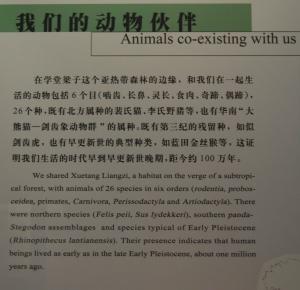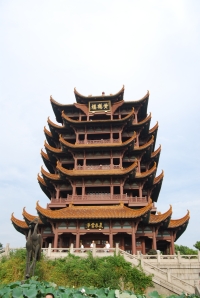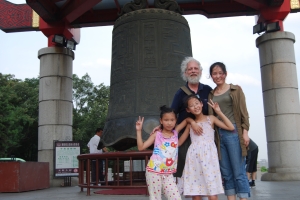WUHAN, HUBEI — After totality was over on July 22, the clouds moved in, and watching the end of the eclipse was unrewarding. So, we packed up our stuff and set off to explore this sprawling city of 9 million people.
We had an ambitious plan: visit Wuhan University, Hubei Provincial Museum, Huang He Lou (Yellow Crane Tower), Wuhan Botanical Gardens, Mo Shan, maybe go shopping …
We did about half those things, partly because we chose to go to the museum first (it’s really big!) and partly because we took the right bus, going the wrong direction, to visit the tower. We got a cheap (2 yuan) hour’s long tour of Wuhan by taking the long way to Yellow Crane Tower.
The provincial museum is fairly new, and showcases a huge collection of 2200-year-old artifacts unearthed in the late 1970s from sites in the northern part of Hubei. There is also a section highlighting the prehistory of Hubei — including fossils of Homo erectus (Yunxian Man) and contemporary animals.
[Note to creationists: those animals did not include dinosaurs. Dinosaurs did NOT co-exist with humans in China, or anywhere else for that matter. This sign makes that concept very clear.]

Homo erectus and fellow animals
And yeah, not to state the obvious, it is somewhat awe-inspiring to realize that China has a recorded history that spans 5,000 years, and that Marquis Yi ancestors (mind you) were undertaking large-scale water conservation projects, building huge bronze smelting and forging factories, mastering astronomy, commerce, art, music, war and probably government bureaucracy long before Europeans did.
(On the other hand, that long history means Chinese students have that much more to learn for their interminable examinations to enter middle school, high school, university and postgraduate school. We Americans complain about 300 years of history — 1/16 that of China’s.)
Not all of the museum’s exhibits are as fascinating, and we actually skipped the less appealing ones. There is a hall of famous people from Hubei, consisting of a photo and short bio (only in Chinese) of each one. The history of writing (we zipped through it) had some interesting displays, but you would need some patience to visit all the displays. [NOTE: Mainland China simplified the character system decades ago, so most modern Chinese cannot easily read traditional characters. Thus, a modern Chinese person has as much difficulty reading 2200-year-old characters written on bamboo splits as a modern American has in reading Beowulf in the original language.]
After the museum, we decided to visit Huang He Lou (Yellow Crane Tower), which is not far away by bus IF you take the bus going in the right direction. Which we didn’t. Armed with a city map (in Chinese), my companion found the correct bus route to take, but both of us failed to realize that boarding the bus directly in front of the museum meant we would be heading west across the Yangtze River on the New Changjiang Bridge, looping through the Hankou district of Wuhan, crossing the Greater Changjiang Bridge heading east, and reaching the Tower a full hour later. Oops!

Yellow Crane Tower
We were not alone. A mom and her two daughters, who kept running into us in museum, and two college students from Shenzhen also made the same wrong choice. The girls, I think, were as fascinated with me as they were with the museum, as the younger of the two greeted me with a bubbly, “Hello, pleased to meet you!” every time she saw me. We entered the tower park separately from them, but met up with the mom and girls at the big bell outside to take some photos of each other.
Yellow Crane Tower is one of the three “great towers” of Chinese history, with the Yueyang Tower and the Nanchang tower in Jiangxi. Each tower now, of course, has been reconstructed in modern times, but the locations have remained constant for at least a thousand years each. Each tower has rich legends about it. Yellow Crane Tower, for example, got its name because a Taoist Immortal living at the site drew a picture of a yellow crane, which came to life. He later flew away on the back of the yellow crane.
Huang He Lou now is a reproduction (built with traditional wood joinery techniques — no nails or other metal fasteners) of the 7-story Qing Dynasty tower built in the 1880s. The Qing era tower was built just a kilometer away from the original third-century tower, which had burned down in 1884. The current tower and park were developed in the 1990s. From the top one can have a commanding view (the original towers had a military purpose) of sprawling modern Wuhan, the Yangtze River (Chiangjiang) to the west and the lakes in Wuchang to the north and east.

Me and the girls from Guangzhou
A short distance from the tower is a huge ceremonial bronze bell. Visitors can ring the bell for 1 yuan each strike, and the pit under the bell was full of 1-yuan coins. We elected just to take photos in front of it.
At this point, it was around closing time, so we went our separate ways. Elektra and I took the right bus going the right way back to our hotel (no ’round the town tours this time!) for dinner and good rest. The next day we planned to visit the Wuhan Botanical Gardens before catching the afternoon train to Changsha.
